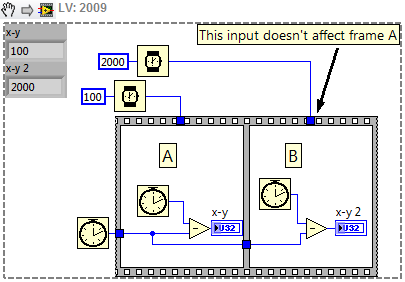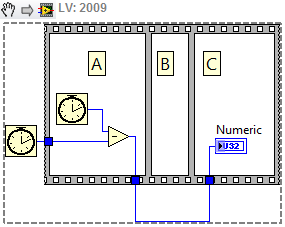-
Posts
2,872 -
Joined
-
Last visited
-
Days Won
45
Content Type
Profiles
Forums
Downloads
Gallery
Everything posted by Yair
-

What is the difference between Global Variable and Functional Global Variable
Yair replied to a topic in LabVIEW General
You can have a look at these two links: http://zone.ni.com/d...a/tut/p/id/5317 http://forums.ni.com.../503801#M240328 And then, if you want, you can also read this, which makes an important point about some of the issues. -
You may need it for backward compatibility, but it should be pointed out that in recent versions the comparison palette has a shipping primitive for checking if an array is empty.
-
There is one exception (sort of) - This actually also allows you to do this, so it also applies to the timing of outputs -
-
Can you provide the reasoning behind this? It seems like a perfectly reasonable behavior in theory, but so does the existing behavior where the outputs are available only after the entire block of code finishes executing, so what would make this "pure" data flow?
-
There's a problem with the variant configuration VIs, where if the cluster has an array of classes, that array can be saved, but it cannot be loaded: The problem comes from the type descriptor analysis, which recognizes the class as a refnum, and thus attempts to create an array of refnums, which the class isn't. I'm not sure if there's anything which can be done about this (because it's quite possible that constructing a temporary LVObject and pushing the flattened data into it will fail because LV expects the object to be of a more specific type), but I did find something that looks like it might allow recognizing the object, as can be seen in the attached VI (LV 2009). Array of classes bug.vi
- 1 reply
-
- 1
-

-
Do you also hate looking for the property or class you want through the whole hierarchy of nested menus? Well, no more - http://forums.ni.com/t5/LabVIEW-Idea-Exchange/Add-Intellisense-support-to-the-property-node/idi-p/1540954
-
Here's a similar site, but more general - http://notalwaysright.com/
-

How to create GUI in LabView - 'Tower of Hanoi'
Yair replied to pinkishred's topic in User Interface
Cross post - http://forums.ni.com/t5/LabVIEW/How-to-create-GUI-in-Labview-TOWER-OF-HANOI/m-p/1540176#M570751 -
Hugo, note that what you have is an External Node, not an XNode. Those have been deprecated and any code you write which uses them will be unusable in later versions of LV.
-
I prefer creating a property node for any of the controls in the FP. It doesn't matter which property it is and you don't have to do anything with it. The advantage to doing this is that you can add a comment next to the property node so that this does not break accidentally. I have also asked relevant people at NI specifically about this and they said this shouldn't break in future versions due to future optimizations, etc.
-
I don't think that the code there is locked. If I remember correctly, you can open the specific VIs in that XNode and look at their code. You can find another example here (and in other posts Darin made), but I don't think you'll find a full tutorial anywhere. At the moment, if you want to use XNodes, you will probably need to hunt down the information yourself. You can't collapse code without using a subVI, but there is a shortcut - select the code you want and select Edit>>Create SubVI. You can see more on this in this discussion - http://forums.ni.com/t5/LabVIEW-Idea-Exchange/Allow-Hide-Unhide-of-code-inside-Block-Diagram-without-using/idi-p/1495972
-
I see that Daklu has finally managed to hack into Shaun's account.
-
Wasn't it deprecated long ago? No. Those were external nodes. XNodes are fine. How do I use xnodes? Don't know. There's no proper documentation (since it's not an officially supported feature), but you can look through the LV wiki or look at actual example. Basically, you should have VIs which are called when specific events occur (such as when the user wires something into the node). Should I use xcontrols? Is it ok to use it inside a commercial product? XControls are fine and officially supported. XNodes are not officially supported, but that does not mean they won't work, just that you won't get official support from NI if they don't work and that they might change between versions. Personally, I probably wouldn't use my own XNodes in commercial apps unless it was really necessary. I took a look at JKI Right Click Framework, will it suite my needs? I don't know. The RCF allows you to invoke specific plugins on the code you select. You could probably write a plugin which does what you want, but I didn't look at your actual code.
-
I haven't looked at your VI, but it sounds similar to this - http://forums.ni.com/t5/LabVIEW-Idea-Exchange/General-Comparison-Operator-as-an-Express-VI/idi-p/1281168 (and be sure to read all of the comments, as there's a working example there as well).
-

The draw backs of multiple inheritance
Yair replied to Grampa_of_Oliva_n_Eden's topic in Object-Oriented Programming
Yeah. That, or saying "you know what, we want it to be able to morph into an armored vehicle with rockets and guns and flying cameras. That's an easy change, right?". <iframe title="YouTube video player" width="480" height="390" src="http://www.youtube.com/embed/GaTW2mkmCFs" frameborder="0" allowfullscreen></iframe> -
Well, if you're staying in Austin I think you'll still be welcome at the LAVA BBQ even after this year. Good luck. P.S. Jive powers the NI community. You could tell them it would be good PR to solve whatever issues it has open.
-
Yes. LV 2010.
-
This old idea never got the attention it deserves - http://forums.ni.com/t5/LabVIEW-Idea-Exchange/An-output-terminal-for-feedback-nodes-that-mirrors-the/idi-p/927458
-
Ignoring heroics and the whole discussion, there seems to be at least one flaw here. In the beginning of the article, he says: His analysis of the soldier's action is based on the second definition, but he does not seem to account for the first definition, i.e. that the soldier jumped on the grenade to save the others because he was concerned for their welfare, despite the certain fatal damage to himself.
-
Options: Don't use the revision history at all. That's what the SCC is for. Of course, that means you have to remember all the changes you made in order to log them. Try using an older version of LV (such as 7.0) to read the data from the VI, as it will load faster. My guess is that this will probably not work, as it will fail when trying to open a reference to the VI. There's apparently an option of activating scripting support in an EXE. This might be enough to allow the EXE to also read the revision history property. See here - http://decibel.ni.com/content/message/10063#10063
-
If memory serves, you can right click the class in the project and do a save as.
-
Reference material? Pure guess - changes in the compiler. This assumes that a) you know how the subVIs/prims handle errors and b) you don't want to do anything with the "local" error yourself (such as appending data to the source element). Not necessarily a problem (although B is if you want to be sure you don't lose error data), but it's easier to add the ECS in when you start and then you don't have to worry about this. Luckily, my code never has errors, so I don't run into these issues.
-
I believe the term you're looking for is "modeless". I haven't looked at the code, but can't you simply do this by changing the VI's display options to be floating and removing the minimizing and resizing options? That shouldn't require any code.
-
I haven't seen this problem recently (except for this - ), so I'm hoping it's not back. In any case, at the bottom of the "last 24 hours" page there's a ring which let's you change the time frame to two weeks or more.
-
I take it that a Scottish James Bond with a French-Canadian accent is your response to Sean Connery being an Egyptian Spaniard?




